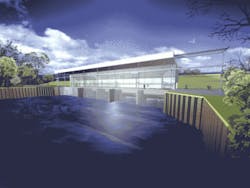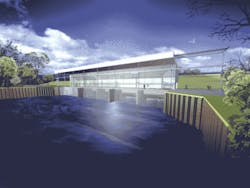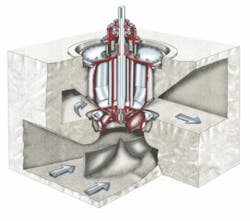St Germans pumping station construction underway in UK
Together, KSB and Bosman Watermanagement developed a solution at the St Germans pumping station that enables each pump to automatically adjust in accordance with actual flow demand.
Construction of the UK’s largest land drainage pumping station, involving the building and supply of six enormous Bosman Watermanagement Beveron concrete volute casing pumps complete with KSB SEZ hydraulics and associated drives, is underway. Mounted on 4.5-m-shafts, the 2.10-m-diameter impellers produced for the pumping station will be the largest ever built by the German manufacturer KSB.
The Middle Level Commissioners at Wiggenhall St Germans, Cambridgeshire, in the East of England is undertaking the estimated £38-million project. It will replace the existing pumping station that was commissioned in 1934. The new pumping station will come on line in the summer of 2009 and is scheduled for formal opening in January 2010.
The existing pumping station at St Germans currently comprises four pump sets and has a total normal capacity of 70 cumecs. However, its replacement will comprise six pump sets each capable of raising some 16.66 cumecs to a static head of 4.25m and will be expected to be called upon to provide this level of output at any time during its 75-year design life.
Located to the south of the Wash Estuary, the Middle Level catchment comprises 70,000ha of arable land, fenland village and towns, and is a closed system, in that there is no gravity outfall. Several hundred years of wind erosion and man-made drainage (since the 1500s) has caused much of the area to be below sea level. Classed as Grade 1 agricultural land, the lowest part of the Middle Level is furthest from the sea and in parts are some 3m below tide level. It is considered by some to be the UK’s most valuable agricultural land.
The catchment contains natural rivers that have been modified and manmade drain courses, with the Middle Level Commission looking after the largest and longest arterial drains. There are many smaller pumping stations feeding into the Middle Level systems via drains, the majority of which are the responsibility of a number of Internal Drainage Boards located throughout the Middle Level. The Middle Level differs from the adjacent North and South Levels in that it the majority of the arterial watercourses are statutory navigations with the Middle Level Commissioners being responsible for the upkeep of these waterways.
Currently the catchment is drained via two major pumping stations. Closest to the sea, St Germans sits out on a limb northeast of the area that it serves. Bevills Leam is a booster station located much further inland. Surplus water from the system is discharged through St Germans into the tidal Great Ouse River close to its sea outlet. Much of the Middle Level would be at risk of being under water at certain times of the year or following a high tide without the St Germans pumping station. With the combined value of land and property estimated as being in the region of £3.6 billion, the expenditure of £38m on a new pumping station is more than justified.
In April 1998 the Middle Level had a wake up call when adverse climatic conditions in the catchment put the pump and drainage systems under immense pressure, almost to bursting point. At the peak of the event the various Internal Drainage Boards were instructed to stop pumping because the Middle Level was almost full and the four original Gwynne’s Invincible pumps at St Germans were operating at maximum capacity. Post event analysis indicated that this had not been a 100-year return period rainfall event and as a result, an extensive study was commissioned that consequently identified the various works that were needed to be taken to provide this level of protection. Most significantly, this included a decision to replace the 72-year-old St Germans station as the number one priority.
New St Germans
Following an exhaustive study undertaken by Atkins Water to determine the preferred option for improving the pumping facilities, the decision was taken to construct a wholly new pumping station instead of upgrading the existing facility. Three different pump type options were examined and costed out. These included: six concrete volute pumps, eight suspended bowl pumps and six humpback (horizontal axial flow) pumps. In addition, seven different locations were considered for the new pumping station. The final decision was to employ concrete volute pumps and to locate the new pumping station a short distance downstream from the existing facility.
In order to ensure no interruption of the existing pumping capability, the new pumping station construction, which will be on-line on the Middle Level main drain, will require a local widening of the drain to accommodate a bypass channel and a coffer dam within which the new station will be constructed. Once commissioned, the bypass channel will be blocked off, the coffer dam removed, and the old station opened up. The presence of the old pumping station will present a hydraulic restriction to flow during draining to the new station and the demolition of the existing sluice structure within it is seen as the minimum requirement to allow water to drain into the new pumps. Once this has happened, the old station will be dismantled.
Water volume varies considerably throughout the year, which makes it necessary for the new pumps to be able to cope both with very low flow levels during summer months and the very worst case scenario. Concrete volute pumps provide the capability to satisfy the full range of pumping heads and give a minimum of 50 percent maximum design flow at the maximum 1-in-200-year high tide event. This option has the advantage over other designs considered in that the total motor power is less, thereby reducing the electrical and secondary power costs. However, given the size of the new pumping station, the local road and power supply infrastructure is to be upgraded.
The pump design and construction brings together the design engineering resources of KSB Aktiengesellschafft with its proven SEZ vertical tubular casing pump and Bosman Watermanagement B.V., the developers of the Beveron concrete volute pump. The main pump components are: the pump stator housing, shaft, upper axial/radial bearing, shaft seal, lower radial bearing, removable wear-ring and impeller.
Such is the size of each pump, the volutes and suction boxes are to be cast on site using form work designed and manufactured by Bosman Watermanagement. The volute has been designed specifically to match the KSB impeller and has a very high hydraulic efficiency. A feature of the volute is the flat floor and trapezoidal flow cross section. The construction of the volute, suction bell and removable cast iron wear-ring in which the bronze impeller rotates have to be to an exacting standard in order to ensure that they conform to the profile of the impeller and that the water side surfaces are of a very high finish. KSB will be working alongside the main contractor on this aspect of the construction work.
The Beveron vertical pump is designed for easy lifting and inspection of all components that are subjected to wear. The pump’s resistance to cavitation ensures that optimum efficiency is attained throughout the service life. The maintenance and wear-free RESIDUR bearing operates without the need for external cooling or lubrication and should water levels drop to a very low level the pump will tolerate temporary dry-running during start-up. At St Germans, the design of the installation means that the open mixed flow impeller should be constantly submerged, which has the benefit of removing the need for priming when starting up the pump.
Although the suction conditions are fairly stable, the discharge head can vary between 8m and 0.5m above the suction. When extreme tides are encountered, there is the possibility that there is no discharge head at all. Thus, under high suction head and low discharge head, air extraction in the discharge main is required in order to enable full bore flow.
The Bosman stator comprises a fabricated body, upper bearing set, shaft seal, bearing column, and lower bearing set. The entire assembly is filled with 11 cubic meters of water, which acts as a reservoir for the “liquidyne” shaft seal. The upper bearing set of the stator is attached by flanges to the upper side of the load-bearing support flange. The shaft seal located on the pump cover on the bearing seat has an upper and lower arrangement and is lubricated by clean water from the stator. Two metering pumps are used for the seal flushing system, with half the clean water being returned to the stator storage tank and half flushed down the shaft between the lower seal and lower bearing. The presence of an inflatable shaft seal arrangement allows the shaft seal to be replaced under pressure in situ.
The upper bearing set holds the stator in place, absorbing the axial and radial forces imparted by the impeller. The lower bearing is non-wearing and because of its location in the impeller boss it has good heat transfer properties as it is in a submerged position. Coupled to the pump shaft and supported on a concrete ring above the volute is the Prienfalk planetary gearbox complete with motor lantern. This has a maximum performance of 131rpm, but typically operates at 128rpm. The pump can be run beyond 50Hz if required.
As the station has the capacity to deal with extreme events, it has been estimated that in a typical year the Commissioners may only require three of the six pumps to run concurrently. However, to ensure that all of the pumps get an equal amount of use, a rotation program will be implemented. This project enables both KSB and Bosman Watermanagement to demonstrate the effectiveness of their fluid handling technologies and design capabilities. Significantly, unlike the existing pumping station, the new St Germans can be operated unmanned, using telemetry and SCADA control from the Middle Level Commissioners’ headquarters in March 2007, approximately 10 miles distant.
The key benefit of the St Germans pumping station is that each of the pumps is capable of adjusting to a wide range of flows. Together, KSB and Bosman Watermanagement have produced an effective and cost-efficient solution that will result in each of the pumps performing in accordance with the actual flow demand and being capable of an immediate response should circumstances change.
Author’s Note
Dipl.-Ing. Reimer Bojens is in charge of systems engineering in the water department of KSB, based in Frankenthal, Germany.



